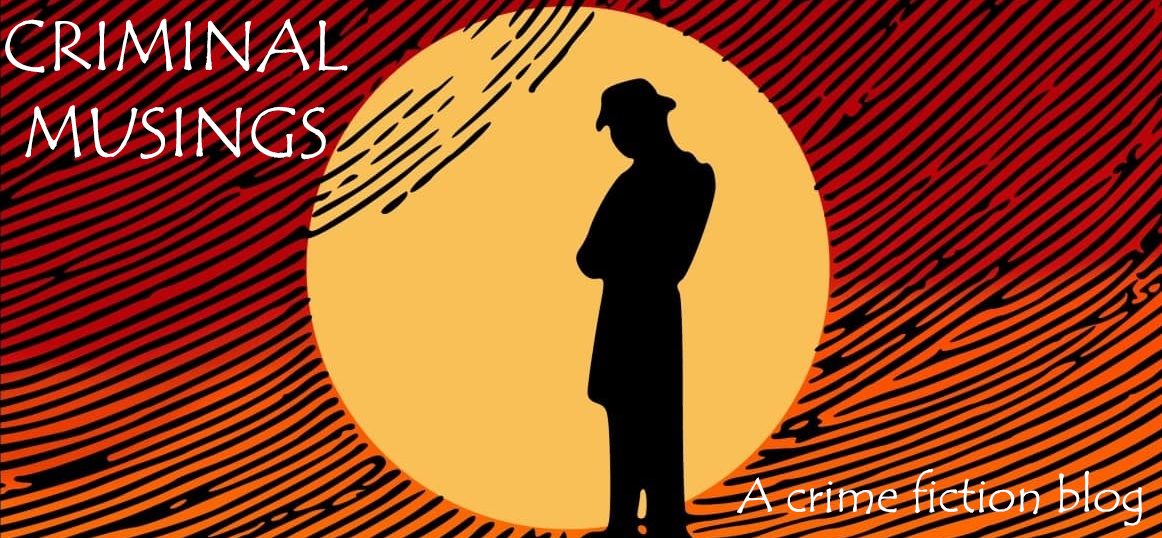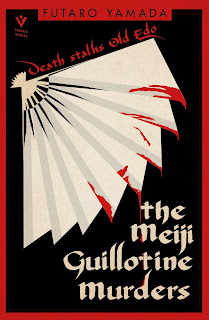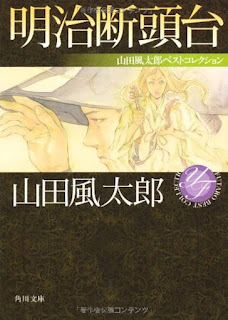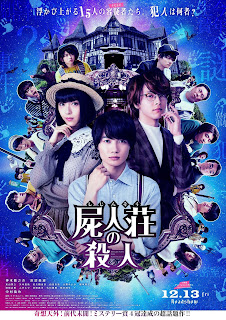The cover of Pushkin Vertigo's 2023 English edition of Fūtarō Yamada's 1979 novel, Meiji Dantodai (translated as The Meiji Guillotine Murders) briefly describes the book as follows: "Death stalks Old Edo". It is, I feel, a curiously appropriate descriptor, for reasons that go beyond the initial impressions one gets from it.
Starting out as a mystery author, Yamada (1922–2001) is perhaps best known for his works of historical fantasy such as Kōga Ninpōchō (The Kouga Ninja Scrolls) and Makai Tenshō, many of which have been adapted to films, manga and anime multiple times. A prolific writer, he left his mark in the world of crime fiction as well—The Meiji Guillotine Murders being a top-tier example. It should come as no surprise, though, that what this book shares with his fantasy works is a preoccupation with all things historical.
For me, in a work of historical crime fiction, the historical elements should add to or elevate the experience of consuming the mysteries. These elements, however, should not lead to either of the two circumstances mentioned below:
The Meiji Guillotine Murders stands out as a shining example of how to imbue a work of mystery fiction with historical details in a manner that does not come across as overbearing. It helps that Yamada is a gifted storyteller—The Meiji Guillotine Murders oozes with an old-world charm (replete with local, cultural details) that transports readers to the era it is set in. Even more important is the ways in which the narrative presents itself—the book unfolds first almost like a jidaigeki (period drama) with the flashy, dramatic appearance of the protagonists, then it evolves into a torimonochō (a somewhat ambiguous term for a style of fiction that imitated the personal 'case notebooks or logs' kept by investigators or police personnel). The use of both forms helps Yamada exercise a reasonable level of creative liberty and dramatisation while also accurately portraying real-life, period-specific politics, events, places and material things.
The novel is set in the aftermath of the Boshin War (1868–1869) and the onset of the Meiji Restoration (1868), the events spanning a three-year period between 1869 and 1871. An era of acute socio-political turmoil marked by several high-profile assassinations, these years saw the fall of the Tokugawa shogunate, the restoration of Imperial rule, and the opening up of the country to the West. Not surprisingly, this period of "chaos-cum-fallowness" was defined as much by "a nationwide sense of collapse" as it was by "a sense of heartfelt relief at the dawning of peace"—a time when "new government sprouted up like bamboo shoots, when new administrative orders came down from on high like rain, and when new customs and ideas came flooding in like a deluge from a harbour", but which also saw "even stranger offices, laws and notions from the old days [...] revived like the souls of the departed and combined, as though mixing together the seven colours of the rainbow—who could say then whether for better or worse—with the end result a chaos of ash-grey."
One of these "even stranger offices [...] from the old days" revived after the Meiji Restoration was the Imperial Prosecuting Office, a long-forgotten institution from the seventh and eighth centuries (CE) that tackled corruption within government departments. The opening two chapters establish the broader context in which the work is set, and introduces readers to the main cast of the book—the two shining lights of the Imperial Prosecuting Office, Chief Inspectors Keishirō Kazuki and Toshiyoshi Kawaji, a French woman Esmeralda Sanson, and five rasotsu ('policemen') who cheat and exploit commoners. The two chapters may not feature mysteries, but are very entertaining nonetheless—Yamada achieves this by presenting well-defined, distinctive characters and scenarios. Keishirō and Toshiyoshi can be recognised by their appearances—Keishirō flaunts a suikan, while Toshiyoshi wears a fuka-amigasa hat, and their apprehension of a vicious gang of robbers resembles scenes from a jidaigeki or a torimonochō drama. With her blonde hair, Esmeralda Sanson is even more of a rarity—a descendant of the infamous Sanson family of Parisian executioners, she is brought to Japan by Keishirō, along with a guillotine which the Imperial Prosecuting Office intends to use for executions instead of the traditional sword. The chapters also establish roles for supporting characters—in the first chapter, for instance, the five rasotsu, who serve as sidekicks, are portrayed as lazy, sleazy and greedy, through a series of amusing sketches. But, what also becomes evident is the reasons they resort to such dishonesty—ranging from the situations in their homes and families to the ways in which these ex-samurai are dealing with changing, conflicting loyalties, and the demands of the new era. Similarly, in the second chapter, readers are exposed to the simmering chaos of the times, and the far-reaching effects of a political assassination—from the way in which the different hierarchies in the Imperial Prosecuting Office and other government departments exploit the situation for their own ends, to how the assassination ends up affecting the conversations and relations between Toshiyoshi and Keishirō, and in their circle of friends and family. What is also established is the 'conceit' that will enable Esmeralda to stay and operate in a Japan that is almost hostile to her.
The mysteries start in earnest from the third chapter onwards, once the groundwork and the rules have been laid. Each tale of mystery (barring the last) begins with a brief segment of a report made by Toshiyoshi that provides a basic outline of the case in question, and ends with a 'performance' by Esmeralda dressed up as a miko (priestess) who communicates with the spirits of the deceased which reveals and denounces their killers. In the first mystery, "A Strange Incident at Tsukiji Hotel", a body is found sliced in half in the great hall of the hotel below the bell tower. In the next one, "From America with Love", a rickshaw with a man plunges into a river drowning its occupant. In the surrounding snow-covered landscape, however, no footprints of the rickshaw-puller are discovered, leading to rumours that the ikiryō (a vengeful, evil spirit) of a war criminal must have committed the deed. "The Hanged Man of Eitai Bridge", on the other hand, unfolds as an alibi-deconstruction story where the victim was hanged from a bridge with the suspect nowhere near the scene of crime. In "Eyes and Legs", people witness an act of decapitation through a telescope, and even though amputated legs are recovered from the site, the victim is never located. Lastly, "The Corpse that Cradled its Own Head" concerns the investigation into a case in which the beheaded body of a certain person of interest, defiled with manure, appears at a farm.
In brief, these puzzles form the crux of each story—and, for me, each puzzle and trick boasts of a level of chutzpah comparable to the pranks seen in the Home Alone series. Except, one also recalls how effective young McCallister's snares and traps were. The tricks seen throughout The Meiji Guillotine Murders are just as inspired, unexpected and deadly, if not more. But, that only reveals a part of the picture. A major reason why the books operates as an excellent historical crime narrative is because it blends tradition and modernity, even when it comes to the question of murder mechanisms. From a materialist perspective, it is wonderful to see recently introduced innovations and tools become contraptions of murder. For instance, the functioning of the novel guillotine inspires the perpetrator in "A Strange Incident at Tsukiji Hotel" to come up with his own instrument of execution involving traditional Japanese articles. "From America With Love" sees the newly introduced mode of transport, the hand-pulled rickshaw, become a terrifying contraption of death—one that can be used to move a corpse without leaving any human footprints behind. "The Hanged Man of Eitai" sees another new vessel that transformed waterways businesses and transport—the steamer—being used to reduce time taken to travel between places and thereby, create an alibi. In "Eyes and Legs", the telescope is used not only to gaze upon the changing physical and socio-economic landscape of Edo, but also to look at and reveal modern surgical practices and newer varieties of crime emerging in a new era. The collaborative performances of Esmeralda, Keishirō, and the rasotsu, in the denouement of each case, certainly adds a theatrical element to the proceedings by revealing how each of the contraptions was used.
It is worth noting that the conversations, decisions and actions of several characters in the background play a significant role in influencing Keishirō, Toshiyoshi and Esmeralda. However, because they are used in a non-intrusive manner and blend seamlessly with the stories, the reader would be hard-pressed to realise that many of them are historical figures—Toshimichi Ōkubo, Takamori Saigō, Takayoshi Kido, Yukichi Fukuzawa, Shinpei Etō, Gensai Kawakami, Nagamichi Ogasawara, Dr. Hepburn, Ginkō Kishida, O-Den, Tomomi Iwakura, Kanzō Uchimura, Tanosuke Sawamura, Aritomo Yamagata, to name a few. In fact, the protagonist Toshiyoshi Kawaji is a real-life figure said to have revolutionised and modernised the Japanese police force. The fact that a lack of awareness about the historical import and significance of the characters does not detract the readers or diminish their enjoyment of the story is a testament to Yamada's superb skill as a storyteller that enables him to integrate these 'easter eggs' that only elevate the audience's experience of and engagement with the work.
From a literary standpoint, The Meiji Guillotine Murders seems to initially develop as a torimonochō story. Adding to this perception is the atmosphere the work creates and sustains, with an emphasis on the 'images-of-the-floating-world' aspect of old Edo—as seen in sections such as "when they saw the fantastic vision of a Heian courtier, seemingly floating before them in a moonlight-drenched Tokyo alleyway, they stopped, spellbound" and "the enormous windows on all four sides of the room had been flung open to the vast autumn night sky with its countless twinkling stars. None of the assembled guests was looking at them, however. It was as though everybody were floating in another dimension altogether." The immediate comparison is with Kidō Okamoto's The Curious Casebook of Inspector Hanshichi: Detective Stories of Old Edo, an anthology of atmospheric Holmesian short stories set in the Edo of the 1850s, with a languid, nostalgic air about it. The Meiji Guillotine Murders, however, does sketch the socio-political reality of the times to a greater extent and with more urgency, especially in the concluding chapter, "Can There be a Just Government?", which radically changes the nature of the story—from a series of chronological but disjointed stories to a linked-story novel. Not only does it tie up and resolve several discrepancies, it also fundamentally subverts and alters the role of the rasotsu—from being sidekicks and comic foils to being critical components of an all-encompassing criminal plan, plotting their own redemption (of sorts). And it is here that the metaphor of death stalking old Edo gains extra layers—as it turns out, just like the murderers in the individual stories stalk their prey, the rasotsu also follow and stalk these murderers, playing the role of masterminds and facilitators in the background, and providing them with insights, inspiration, and critical services at the right moments, for the furtherance of their objectives.
With its focus on corruption in the old shogunate order as well as in the new Meiji administration, The Meiji Guillotine Murders perhaps resembles Shōtarō Ishinomori's 1966–1973 manga, Sabu to Ichi Torimono Hikae (Sabu and Ichi's Detective Tales) more closely than it does Okamoto's Hanshichi. In Ishinomori's beautifully illustrated but bleak work set in the dying years of the Tokugawa shogunate, Sabu, a young thief-taker, and Ichi, a blind masseur, navigate the harsh Edo landscape populated by a society, impoverished and in ruins, dealing out their severe and fierce (but not unsympathetic) brand of justice to bandits, rouge samurai and corrupt officials, while bemoaning the decaying and rotten state of affairs in the upper echelons of the shogunate that spells unrelenting misfortune and tragedy for the common people Sabu and Ichi try to protect. Neither work quite explicitly puts forth a political opinion or standpoint, but they do share the common theme and agenda of portraying the inherent and deeply embedded corruption in both new and old world orders, and the effect it has on the people who bear its brunt. Even beyond Japan, the use of a linked mystery-story approach to reveal a larger issue in the background has grown in popularity, particularly in the recent spate of Chinese detective shows (such as 2022's Checkmate, an adaptation of a number of Agatha Christie's Hercule Poirot stories set against the backdrop of a Republican China) featuring Shanghai and/or Beiing of the 1920s or 1930s.
 |
| Reflections after vanquishing the misguided foe (panel from Shōtarō Ishinomori's Sabu and Ichi's Detective Tales, chapter 83, January 1973) |
It is safe to say that The Meiji Guillotine Murders has been one of my best finds of the year. Taking inspiration from its predecessors in the genre, the book goes on to lay down an enviable template for future authors dabbling with the historical crime fiction genre to try and emulate—take, for instance, a completely different work such as Honobu Yonezawa's excellent The Samurai and the Prisoner that still feels quite similar to Yamada's work with regards to its modus operandi of stringing individual stories together in the climax. The Meiji Guillotine Murders comes highly recommended, indeed!






